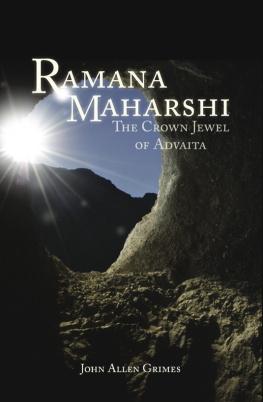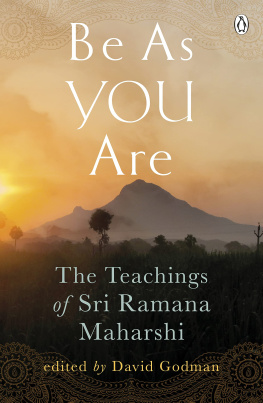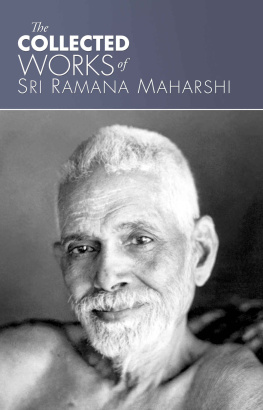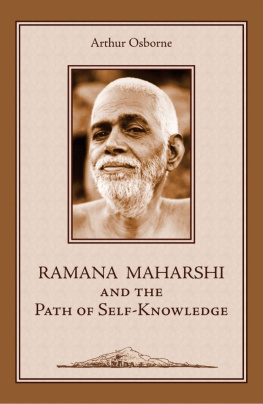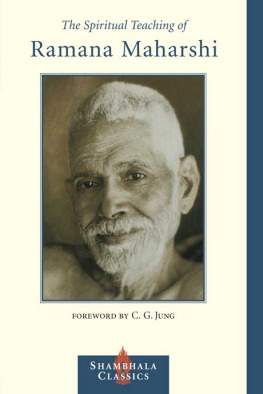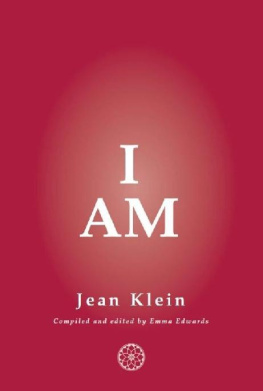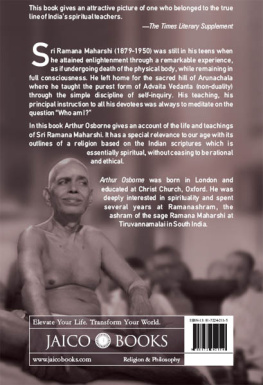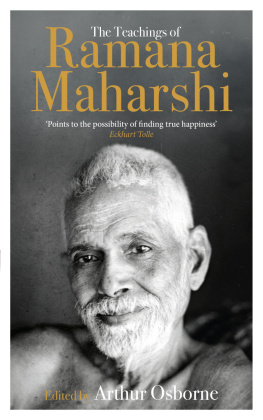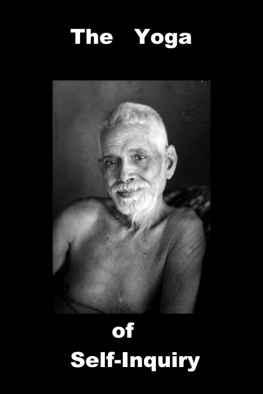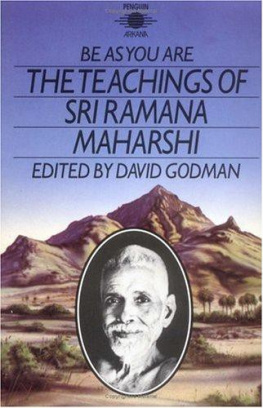Ramana Maharshi
The Crown Jewel ofAdvaita
John Allen Grimes
Published by Albion-Andalus Books at Smashwords
Boulder, Colorado 2015
The old shall berenewed,
and the new shall be made holy.
This ebook may not bere-sold or given away. No part of this bookmay be reproduced or transmitted in any form or by any means,electronic or mechanical, including photocopy, recording, or anyinformation storage or retrieval system, except for brief passagesin connection with a critical review, without permission in writingfrom the publisher:
Albion-Andalus, Inc.
P. O. Box 19852
Boulder, CO 80308
www.albionandalus.com
Design and composition by Albion-Andalus,Inc.
Cover design by Sari Wisenthal-Shore
Manufactured in the United States ofAmerica
ISBN: 9781311237064
To
Bhagavan Sri Ramana Maharshi
& Professor R. Balasubramanian
Who imparted the timeless wisdom ofAdvaita
To myself and oh so many others.
Contents
Early Life ~ The GreatChange ~ The Call to Arun cala ~
Life at Tiruvannamalai ~Life on Aruncala ~ Mah sam dhi
Introduction to IndianPhilosophy ~ What is Ved nta? ~ What is Advaita Vednta?~
Synopsis of Advaita Vednta~ Absolute Non-Duality ~ Three Approaches to
Creation Theories ~ The KeyConcept of Advaita ~ Liberation-While-Living ~
Ramaa as a Philosopher ~Ramaa and Free Will
Introduction ~Epistemolgical Issues ~ Ramaa and Epistemological Issues~
Distinction betweenStandpoints ~ Vrtti-jn na ~ HowCan Duality Reside
in Consciousness? ~Perception ~ The Process in Knowing
Ramaa and Reality ~ Ramaaand M y ~ Ramaaand
Causality ~ Ramaa and theIndividual
Introduction ~ VirtueIncarnate
Self-Enquiry ~ Surrender ~Other Disciplines ~ Satsag ~ Liberation
Jvan-mukti ~ TheSadguru
Preface
Some thirty years agonow , from 1978-1985, I attended theRadhakrishnan Institute for Advanced Study in Philosophy as a M.A.and Ph.D. student. I went there for a number of reasons. First, Ihad a deep and abiding interest in Advaita Vednta philosophy andthe Radhakrishnan Institute had a glowing reputation as an advancedstudy centre specializing in Advaita. Beginning with SuryanarayanaSastri, and continuing through T.M.P. Mahadevan, R.Balasubramanian, and P.K. Sundaram, one cannot imagine the depth ofknowledge and immense joy I had in studying there. Secondly, partlydue to its location, and partly due to the interests and devotionof these professors to Advaita, there was an intimate connectionbetween the Institute, Ramaa and the Ramaramam, and theParamacarya Sri Candrasekarendra Sarasvati and theK c Ma ha, just an hour or two down the road.
Ramaa has often beencalled an Advaitins Advaitin. He has been praised as one of thegreatest living embodiments of Advaita Vednta, as great as thegreatest of that illustrious group. Such a wonder the world seldomsees. He has often been described as an incarnation of Advaita.The description is an intriguing philosophical oxymoron as thethunderous truth of Advaita boldly declares that no one has everbeen born, lived, or died, and yet it is, without doubt, anastonishingly powerful image in conveying the profound affinitythat exists between the teachings of Advaita and Ramaa. As onepasses the philosophically relevant portions of Ramaas teachingsthrough the lens of Advaita, they will be seen to be in perfectaccord with the essence of Advaitas philosophical teachings. Whatis all the more astonishing is that Ramaas teachings emergedspontaneously as the fruit of his sudden Great Awakening and onlysubsequently, almost by accident, did he learn of the ancientUpani adic andAdvaitic teachings.
This book is an attempt toview, to see ( daran ) the life and teachings of Bhagavn r Ramaa Maharshi through the lensof the philosophical system ( darana ) known as Advaita Vednta.Replying to a question from a visitor to r Ramaramam, Ramaasaid: To have daran (being in the presence) of a Sage is sure to bring good toyou. Thousands of people pass by Tiruvannamalai in trains everyday, but few alight here and fewer still visit the rama . About daran of, andassociation with, a Sage, the scriptures say that it is a vesselthat enables you to cross the vast ocean of birth and death( samsra ). Whatmore benefit do you want?
Not only does the word daran meanbeing in the presence of a Sage or deity, but it is also thenearest equivalent Sanskrit word for philosophy. Darana , from theSanskrit root dr , meaning to see implies not only vision (which includesinsight, intuition, and vision of the truth), but also theinstrument of vision (such as viewpoint, worldview, doctrine,philosophical system). In a word, darana implies sight in all itsmyriad connotations, and the term, like many Sanskrit terms, ismulti-significant, multi-valent. Thus, besides expressingviewpoints or perspectives, the term also suggests the idea ofright vision or realization ( moka ). The former meaningcustomarily refers to the six great orthodox Indian philosophicalsystems ( a darana ).Here, it is not so much a search for the truth as it is anexposition, elaboration, clarification, vindication and conceptualfixation of what has been received. The latter meaning, on theother hand, refers to the person experiencing a vision of orinsight. In this case, it is direct, personal and experiential. Inother words, the seeing implied by the term darana includes both conceptualknowledge and perceptual observation, critical exposition andintuitional experience, logical enquiry and spiritual insight,concrete and abstract, gross and subtle. The English expression Isee contains a hint of this multi-valence in that it denotes botha direct vision as well as a correct understanding.
Darana , as a systematic elaboration of the truth, encompassesfundamental interpretations of reality more commonly known as theclassical philosophical systems. In this technical sense, the termembraces the different streams of philosophical thought runningparallel to one another and which were engaged in mutual dialogue,discussion, debate, criticism, and counter-criticism for the pasttwo thousand years.
Thus, the word daran is richwith meaning. To study, understand, interpret, and continue thescholarship of the Indian daranas it is imperative that one realize that itholistically both implies thinking and living, theory and practice,an ancient, continuous, and seamless tradition. It has been able tocombine, in an almost unique manner, conformity to tradition withan adventurous, enquiring mind.
I cannot express in wordsmy heart-felt gratitude to Professor R. Balasubramanian forsuggesting that I should write a book on Ramaa and philosophy.Only a spiritual aspirant can truly understand the immense joy thatcomes from reading, reflecting, and reveling in Ramaas teachings.Truly, this is satsag . Further, I couldnt have written this book without havingbeen a student all those years under R. Balasubramanian at theRadhakrishnan Institute. Though I have studied Advaita for many,many years, I am really not competent to write about a Sage such asRamaa. This is not mere lip-service. As has often been said, onlya mukta can trulyunderstand another mukta . All else is but intellectualgymnastics. This being said, I have done my best and I pray thatRamaa, as well as the reader, will forgive whatever blemishesappear in this work. They are all traceable to my own personallimitations for which I sincerely implore your and Ramaaspardon.
I am so immensely thankfulto Chris Quilkey, Editor of the MountainPath at Ramaramam, for providing mewith materials on the life and teachings of Ramaa. They made mywork so much easier. Only a research scholar can truly know howinvaluable his help was. I must also offer my gratitude to ArthurOsborne and David Godman for their selfless service in providingtopical collections of exemplary conversations Ramaa had withspiritual seekers. Finally, I want to thank Martin Wolff forhelping to proofread the manuscript and for making valuablesuggestions.
Next page
